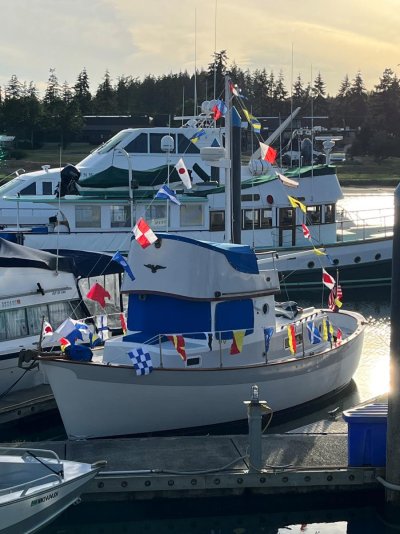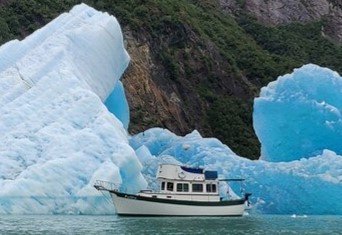Interesting history on the Fales. It was originally the Willard 30 Searcher model. Willard was to collaborate with an east coast builder to construct and market the boat. Best I can tell, the builder was to pay Willard a royalty for each hull built.
The partnership didn't last long. The builder stretched the hull and reconfigured somewhat and ceased royalty payments.
So you are looking at essentially a Willard 30 with full displacement and a few thousand lbs ballast. Top speed might be 7 kts, cruising speed a smidgen over 6 kts burning around 0.75 gph. She probably carries 100 gals diesel in saddle tanks outboard of the Perkins. And 100 gals water beneath the aft deck (which is a decent storage garage, btw)
$27k seems fair, but I wouldn't be surprised if it sold for quite a bit less. A 45 year old small boat showing DIY and liveaboard maintenance can have a hard time finding a home. 6500 engine hours is getting up there, but may mean she's a smooth runner. It wouldn't scare me - probably intrigue me as it means the boat has been used, perhaps Bahamas. But I would use the relatively high engine hours to justify an offer.
Compared to a GB32, I'd take the Fales hands-down for one reason: exterior teak. The Fales has a wood caprail (likely teak), a few cabinet doors, and that's it. The GB with it's transom has more initial stability than the round-bottomed displacement Fales.
On any boat this age, steel tanks need inspection as does rot around interior of windows. The engine in the Fales is pretty far forward which means it has a long prop shaft and likely has at least one carrier bearing. These have a tendency to rust and require shaft to be pulled to replace. Can turn into a Pandoras box project. Also, the stuffing box on my 1972 Willard Searcher was difficult to access and suffered from neglect, but my Searcher had the head compartment aft meaning atuffing box was accessed via a small cabinet so may not be an issue for the Fales.
I didn't see any pictures of electronics. The original Willard 30s had cable steering which was fine, but difficult to adapt an autopilot. I converted mine to hydraulic when I owned her in the 1990s.
Final caution if you inspect the boat is to check concrete ballast. Concrete ballast is decent but does not do well with prolonged submersion. Many owners of all boats tolerate wet bilges which is okay even for concrete, but if left with standing water for years, the steel punching used for weight will rust and swell which pulverizes the concrete.
These are simple boats. Would be a nice boat to run to thr Bahamas. A bit slow, but a nice boat. I lived aboard my 1972 Searcher when I met my now-wife. We cruised the hell out of her in San Francisco Bay, Delta, and a few coastal trips to nearby destinations. We fell in love on that boat.
Feel free to PM me with any other qurstioms. Also the Willard Boat Owners group on groups.io has some limited info on files. May have a more accurate history than I portrayed above, albeit from the viewpoint of Willard Marine.
Good luck in your search.
Peter


